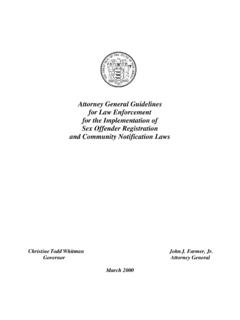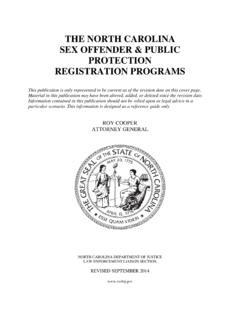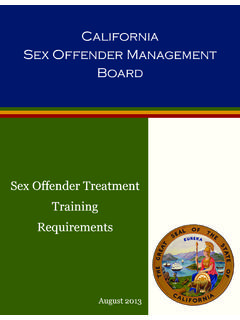Transcription of New Mexico Sentencing Commission
1 New Mexico Sentencing Commission September 2014 New Mexico Sentencing Commission Staff Literature Review Introduction Criminologists have been measuring rates of recidivism for more than a century. Different types of criminal offenders recidivate at varying rates and for different reasons. Sex offenders are no exception and this population requires specific re-offense research of its own. Obtaining valid measurements can be a challenge and there are different ways to define and measure recidivism. Also, the length of the follow-up period used to measure recidivism may affect results. Due to the various ways that sex offender recidivism is defined and measured, caution should be used in making comparisons. How recidivism is defined and measured is distinct to each research project. The findings of any one study likely should not be applied to the entire population of sex offenders. Nonetheless, it is useful to recognize the use of different approaches used in research regarding recidivism by sex offender.
2 Measurement Methods Recidivism rates are determined by using information regarding new arrests, charges, convictions, or clinical information disclosed by a sex offender to a counselor. Other records can be used, such as victimization surveys (Hanson & Harris, 2004) or self-report surveys, although the validity of the latter method may be questionable. There are many choices when deciding how to define recidivism: failure to register, violation of parole or probation requirements, new sex offense, new violent nonsexual offense, any new felony offense, or any new misdemeanor offense. For the purposes of this review, unless otherwise specified, recidivism refers to any readmission to a New Mexico Correction Department (NMCD) facility, sexual recidivism refers to any readmission to a NMCD facility for an offense sexual in nature, and violent recidivism refers to any readmission to a NMCD facility that is violent in nature, but not sexual. Follow-Up Periods The length of the follow-up period used when measuring recidivism rates is important to take into consideration as it can vary greatly from one study to another (see Table 1).
3 In other instances, researchers allow the follow-up period to be determined by setting a number of arrest/conviction incidents and allowing the violations to dictate the follow-up period (see Bench & Allen, 2013). Offender Types Recidivism rates vary by type of sex offender and factors such as: 1) demographic data (Bench & Allen, 2013; Hanson & Bussi re, 1998); 2) criminal history; and 3) victim type (boys, girls, family members, acquaintances, or strangers) (Hanson & Harris, 2004; Hanson & Bussi re, 1998). Demographics include factors like age and marital status. Research shows that younger offenders (Bench & Allen, 2013; Hanson & Bussi re, 1998) and single offenders are more likely to reoffend than older or married offenders. For nonsexual recidivism, Meloy (2005) found that several factors age, prior drug use, number of prior felony convictions, and the number of behavioral and treatment conditions imposed on the probationer were predictive. Sex offenders of similar types tend to have several factors in common, including personality and victim types, and recidivism rates.
4 How these types are grouped can vary from study to study. Hanson and Bussi re (1998) conducted a meta-analysis of 61 studies including information on demographics and criminal history and found that over an average follow-up period of 4 to 5 years the recidivism rates varied by group rapist or child molester as well as by type of recidivism sexual, nonsexual violence, or general recidivism. The sexual recidivism rate for rapists was nearly 50% higher than for child molesters ( versus ) and the nonsexual recidivism rate was nearly twice as high for rapists as for child molesters ( versus ). General recidivism also varied, with a rate for child molesters and a rate Updated Exploratory Sex Offender Recidivism Study: 2004 2006 Probation Sentence & Prison Release Cohorts 2 for rapists (see Table 1 for the combined totals). Other work by Sample and Bray (2006) categorized sex offense statutes by victim age and nature of offense. Over a five year follow-up period, rearrest rates were highest for child molesters ( ) and rapists ( ) (p.)
5 93). Arrests for the same sex offense occurred most frequently for rapists ( ) and those in the other category ( ), which includes crimes such as pimping and soliciting juvenile prostitutes (p. 94). While all categories of offenders recidivated at a rate of less than 10% for any sex crime, child pornographers, the other category, and rapists were most likely to reoffend (p. 95). An analysis in Canada found that rapists recidivated at rates of 14%, 20%, and 24% over 5, 10, and 15-year follow-up periods, respectively (Hanson & Harris, 2004). This same study broke down child molesters by victim type and found that: 1) incest child molesters recidivated at the lowest rate of any type of child molester defined in the study (6%, 9%, and 13% over the same follow-up periods); 2) those with male victims were highest (23%, 28%, and 35%; same follow-up period); and 3) female victim-seeking offenders rates were somewhat lower (9%, 13%, and 16%; same follow-up period, Hanson & Harris, 2004).
6 Treatment Another factor that influences recidivism is treatment. While not broken down by type of offender, Bench and Allen (2013) determined that as a group, offenders who had failed treatment programs were times more likely to recidivate than those who had completed treatment (p. 420). The type, duration, and location of treatment should be considered (Barnoski, 2006; Hanson & Bussi re, 1998; Stalans, 2004). Different sex offender types are more responsive to treatment than others (Stalans, 2004). According to Stalans (2004), psychopathic personality types are much less prone to change offending behavior after going through treatment. Currently, the most widely accepted form of psychological treatment is the cognitive-behavioral approach. This treatment method provides offenders with psychological tools to help prevent relapses into offending behavior (Stalans, 2004; Aos et al, 2006; Marshall & Laws, 2003; Hall, 1995). Schmucker and L sel (2008) conducted a review of outcome evaluations of sexual offender treatment and found treatments (other than non-behavioral forms) could reduce recidivism sexual, violent, and general by approximately a third (p.)
7 10). A relatively new alternative treatment method is the use of serotonin reuptake inhibitors that have a chemical castration effect (Stalans, 2004). This reduces sex offenders deviant sexual urges, but does not completely remove sex drive, and is safer to take in extended doses compared to previous forms of medical treatment (Stalans, 2004). This form of treatment is not as commonly mentioned in the literature as relapse-prevention and cognitive-behavioral therapy methods. General Recidivism General recidivism has a fairly wide range, with some concentration of recidivism in the to % range for a follow up period range of 4-5 years (Hanson & Bussi re, 1998; Hanson & Morton-Bourgon, 2005 & 2009). There are also higher variations such as 69% over 6 years (Milloy, 2007), and 80% over 25 years (Langevin et al, 2004). When broken down by offender type, one study found that the general recidivism rate for rapists is , and for child molesters is for a follow-up period of 4-5 years (Hanson & Bussi re, 1998).
8 Sexual Recidivism Sexual recidivism is concentrated in the to 14% range with a follow up period of 4-6 years (Hanson & Bussi re, 1998; Helmus, Hanson, Thornton, Babchishin & Harris, 2012; Hanson & Morton-Bourgon, 2005 Hanson & Harris, 2004). This range includes a sexual recidivism rate discovered in a 2012 meta-analysis of over 20 recidivism studies (Helmus, Hanson, Thornton, Babchishin, & Harris, 2012). Two studies found that over a 10-year follow-up period, the rates of sexual recidivism were (Hanson & Bussi re, 1998) and 20% (Hanson & Harris, 2004). Other variations in the literature include for sex felonies over a 5-year follow-up period (Barnoski, 2006), 23% for sex felonies over a 6-year follow-up period (Milloy, 2007), 24% over a 15 year follow-up period (Hanson & Harris, 2004), and a rate of 60% over a 25 year follow-up period (Langevin et al, 2004). It should be noted that some studies such as Langevin et al (2004) note a much higher recidivism rate (in several categories of recidivism) are criticized for issues that may bring into question the validity and generalizability of the results.
9 Some of these issues include sampling methods, what definitions of recidivism were used, and the research model for the study. Violent Recidivism Violent recidivism among sexual offenders has a large range, with reported recidivism rates of to , with a follow up range of 4-6 years (Barnoski, 2006; Milloy, 2007; Hanson & Bussi re, 1998; Hanson & Morton-Bourgon, 2005; Boccaccini, Murrie, Caperton & Hawes, 2009). For rapists, violent recidivism is reported at and at for child molesters (Hanson & Bussi re, 1998). 3 a violent recidivism rate of The sexual recidivism rate was Table 2 contains a breakout of the types of charges for new admissions. The findings regarding this cohort are not comparable with the findings presented in the literature review, since the sample is based on a cohort that received probationary sentences only rather than offenders released from prison. Prison Cohort The prison cohort of sex offenders in this analysis consisted of 351 offenders.
10 Offenders in the prison cohort were tracked for prison re-admissions through October 2013. Eleven offenders were removed from the cohort because they died during the follow up period. Of the remaining 340 offenders, 137 were re-admitted to prison ( ). There were a total of 225 admissions. were admitted more than once. Parole violation admissions were the most common admission type ( ), followed by new crimes ( ). Table 3 lists the admissions by category. Looking at new offenses, of those admitted for a new charge were convicted of a violent charge. This is a violent recidivism rate of The sexual recidivism rate was Table 4 contains the breakout of new charges. Next Steps These findings are exploratory and limited to readmission only to New Mexico prisons for the prison and probation cohorts (2004-2006). This analysis Exploratory Analysis of Recidivism Rates for Sex Offenders in New Mexico This analysis was prepared by New Mexico Sentencing Commission (NMSC) staff.







